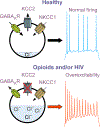Accelerated brain aging with opioid misuse and HIV: New insights on the role of glially derived pro-inflammation mediators and neuronal chloride homeostasis
- PMID: 36584655
- PMCID: PMC9933139
- DOI: 10.1016/j.conb.2022.102653
Accelerated brain aging with opioid misuse and HIV: New insights on the role of glially derived pro-inflammation mediators and neuronal chloride homeostasis
Abstract
Opioid use disorder (OUD) has become a national crisis and contributes to the spread of human immunodeficiency virus (HIV) infection. Emerging evidence and advances in experimental models, methodology, and our understanding of disease processes at the molecular and cellular levels reveal that opioids per se can directly exacerbate the pathophysiology of neuroHIV. Despite substantial inroads, the impact of OUD on the severity, development, and prognosis of neuroHIV and HIV-associated neurocognitive disorders is not fully understood. In this review, we explore current evidence that OUD and neuroHIV interact to accelerate cognitive deficits and enhance the neurodegenerative changes typically seen with aging, through their effects on neuroinflammation. We suggest new thoughts on the processes that may underlie accelerated brain aging, including dysregulation of neuronal inhibition, and highlight findings suggesting that opioids, through actions at the μ-opioid receptor, interact with HIV in the central nervous system to promote unique structural and functional comorbid deficits not seen in either OUD or neuroHIV alone.
Copyright © 2022 The Authors. Published by Elsevier Ltd.. All rights reserved.
Conflict of interest statement
Declaration of competing interest The authors have no conflicts of interest to declare.
Figures


Similar articles
-
Opioid and neuroHIV Comorbidity - Current and Future Perspectives.J Neuroimmune Pharmacol. 2020 Dec;15(4):584-627. doi: 10.1007/s11481-020-09941-8. Epub 2020 Sep 2. J Neuroimmune Pharmacol. 2020. PMID: 32876803 Free PMC article. Review.
-
Opioid Modulation of Neuronal Iron and Potential Contributions to NeuroHIV.Methods Mol Biol. 2021;2201:139-162. doi: 10.1007/978-1-0716-0884-5_13. Methods Mol Biol. 2021. PMID: 32975796 Free PMC article. Review.
-
The Effects of Opioids on HIV Neuropathogenesis.Front Immunol. 2019 Oct 18;10:2445. doi: 10.3389/fimmu.2019.02445. eCollection 2019. Front Immunol. 2019. PMID: 31681322 Free PMC article. Review.
-
Opioid and chemokine regulation of cortical synaptodendritic damage in HIV-associated neurocognitive disorders.Brain Res. 2019 Nov 15;1723:146409. doi: 10.1016/j.brainres.2019.146409. Epub 2019 Aug 26. Brain Res. 2019. PMID: 31465771 Free PMC article. Review.
-
Opioid withdrawal symptoms, a consequence of chronic opioid use and opioid use disorder: Current understanding and approaches to management.J Clin Pharm Ther. 2020 Oct;45(5):892-903. doi: 10.1111/jcpt.13114. Epub 2020 Jan 27. J Clin Pharm Ther. 2020. PMID: 31986228 Review.
Cited by
-
Risk factors for cognitive decline in persons with HIV.Curr Opin Infect Dis. 2025 Feb 1;38(1):37-43. doi: 10.1097/QCO.0000000000001080. Epub 2024 Dec 6. Curr Opin Infect Dis. 2025. PMID: 39641182 Free PMC article. Review.
-
Modulation of oxidative stress/NMDA/nitric oxide pathway by topiramate attenuates morphine dependence in mice.Heliyon. 2024 Nov 22;10(23):e40584. doi: 10.1016/j.heliyon.2024.e40584. eCollection 2024 Dec 15. Heliyon. 2024. PMID: 39719994 Free PMC article.
-
HIV-1 Tat and morphine interactions dynamically shift striatal monoamine levels and exploratory behaviors over time.J Neurochem. 2024 Mar;168(3):185-204. doi: 10.1111/jnc.16057. Epub 2024 Feb 3. J Neurochem. 2024. PMID: 38308495 Free PMC article.
-
Detection of Trace Elements Se, Cu, and Zn Levels in Biological Samples of Drug Abusers: Halani Sindh, Pakistan.Biol Trace Elem Res. 2024 Nov;202(11):4869-4876. doi: 10.1007/s12011-023-04056-6. Epub 2024 Jan 9. Biol Trace Elem Res. 2024. PMID: 38196054
-
The effects of chronic morphine administration on spatial memory and microtubule dynamicity in male mice's brain.IBRO Neurosci Rep. 2024 Feb 12;16:300-308. doi: 10.1016/j.ibneur.2024.02.002. eCollection 2024 Jun. IBRO Neurosci Rep. 2024. PMID: 38390235 Free PMC article.
References
-
- US-HHS: Determination that a public health emergency exists. Edited by Secretary–USHHS. Rockville, MD: US_Health_and_Human_Services; 2017.
-
- CDC-NCHS: Drug Overdose Deaths in the U.S. Top 100,000 Annually. edn https://www.cdc.gov/nchs/pressroom/nchs_press_releases/2021/20211117.htm. Edited by CDC NCfHS, Office of Communications, NCHS Press Room. Atlanta, GA: U.S. Department of Health & Human Services; 2021.
-
- Hodder SL, Feinberg J, Strathdee SA, Shoptaw S, Altice FL, Ortenzio L, Beyrer C: The opioid crisis and HIV in the USA: deadly synergies. Lancet 2021, 397:1139–1150. - PubMed
-
- Lerner AM, Fauci AS: Opioid Injection in Rural Areas of the United States: A potential obstacle to ending the HIV epidemic. JAMA 2019, 322:1041–1042. - PubMed
Publication types
MeSH terms
Substances
Grants and funding
LinkOut - more resources
Full Text Sources
Medical
Research Materials

